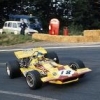So, I'm wondering why some teams dropped back between 1987 and 1988 and why others (like McLaren) became stronger.
Here are some facts about the cars :
Lotus
1987

Model : 99T
Engine : Honda RA166E V6TC
WCC : 3rd (64 pts)
Wins : 2
Poles : 1
Fastest Lap : 3
1988

Model : 100T
Engine : Honda RA166E V6TC
WCC : 4th (23 pts)
Wins : 0
Poles : 0
Fastest Lap : 0
99T :

100T :

Ferrari
1987

Model : F1-87
Engine : Type 033 V6TC
WCC : 4th (53 pts)
Wins : 2
Poles : 3
Fastest Lap : 3
1988

Model : F1-87/88
Engine : Type 033B V6TC
WCC : 2nd (65 pts)
Wins : 1
Poles : 1
Fastest Lap : 4
F1-87 :

Williams
1987
http://uxoros.free.fr/87_88/fw11b
Model : FW11B
Engine : Honda RA167G V6TC
WCC : 1st (137 pts)
Wins : 9
Poles : 12
Fastest Lap : 7
1988

Model : FW12
Engine : Judd CV V8
WCC : 7th (20 pts)
Wins : 0
Poles : 0
Fastest Lap : 1
FW11 :

FW12 :

McLaren
1987

Model : MP4/3
Engine : TAG-Porsche TTE PO1 V6T
WCC : 2nd (76 pts)
Wins : 3
Poles : 0
Fastest Lap : 2
1988

Model : MP4/4
Engine : Honda RA168E V6T
WCC : 1st (199 pts)
Wins : 15
Poles : 15
Fastest Lap : 10
MP4/3 :

MP4/4 :

So, Williams and McLaren changed the engine supplier between 1987-1988. Lotus and Ferrari had both the same.
Lotus has changed the design a lot between the 99T and the 100T. But I noticed that the 100T had some common points with the MP4/4. So why was Lotus back ? Was it because of the engine ?
Also, Williams had quite a good chassis in 1987 and then they drop back the next year. Is that because of the Judd engine ?
Ferrari were quite consistent in 87-88. Why did they use quite the same chassis ? The improved a little bit in 1988 but they just couldn't get the same pace as McLaren.
Finally McLaren. I looked to the MP4/4 and thought "but compared to the FW12, it doesn't looks as fast". Was the chassis FW12 better than the MP4/4 and did the engine only make the difference ?
Only the front of the MP4/4 who looks different, but the engine cover seems to be quite the same as the MP4/3. I know also that McLaren did a lot of testing with the MP4/3 and the Honda engine. Look to these pictures from 1987 :
MP4/3 in race :

MP4/3 in testing (notice the Honda acronym) :

Could we compare this to now and say that the MP3/3 was a "laboratory car" like the MP4/18 today ? Maybe the history could be repeated and McLaren dominate next year like they did in 1988 ??



















